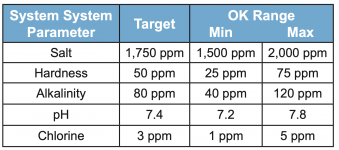I don’t find this entirely true.
In the Hot tub forum it has a lengthy sticky about spas and the target values are indeed different CH in the text. It states if you are over 100 or 150 ppm, you are good to go and no need to increase. This differs from a plaster pool, for example.
It would good if the app could be aligned with the latest TFP recommendations for the type of material used in the construction, etc.
… or the lengthy sticky should be updated to reflect otherwise.
Do note that the sticky was written in 2008, and some things have been updated since. The sticky was left though as there wasn't a suitable all-in-one replacement yet. It's difficult to get a bunch of volunteers to update everything, and spas are not the main traffic to this site. For example, I was asked to assist in writing/updating some articles, but due to a divorce, moving, and loosing my hot tub I had less motivation, and more importantly, less time to help volunteer to update things. We do constantly update things, and I suspect the sticky will at some point be removed. It was actually removed at one point since I've been a member, but due to amount of useful information and complaints about it being removed it was restored. Once we can get all the useful information moved into more usable articles, I suspect it'll be removed again.
For my hot tub I selected fiberglass and it still recommends 350ppm but in this sticky,
How do I use Chlorine in my Spa (or pool)? it states
Hence the confusion and appeared difference in recommendations between app and a sticky.
To expand upon what
@mknauss stated, all modern spas are acrylic, which pool chemistry wise, can be treated the same as vinyl, so in the app, you should select vinyl. Note that changing pool types doesn't change recommended values for anything except CH. Since low CH won't damage vinyl or acrylic, unless you get scaling (which I can't imagine happening in a standalone spa), no CH is needed to avoid damage to the shell, though as mentioned something like 100 ppm is recommended to help with foaming. If you don't have foaming issues, you can probably just ignore CH completely. I did not test for it in my hot tub, but only in my pool occasionally to track it.
The main concern with CH and plaster, is that CH is a large component of CSI, and a CSI that's too negative will eat away at the plaster over time. This is why concrete driveways get rough over time. Look for downspouts that drain onto concrete, the concrete will be eaten away where the rain flows across the concrete more than the rest of the concrete (at least if you live somewhere with rain). Rainwater is very soft, as it's essentially distilled water with no CH, so it has a very negative CSI. I believe this is also why rivers carve canyons into solid rock. Water can't physically carve stone, but it can dissolve it.
For fiberglass, CH has the same recommended values as plaster because a few (mostly old I think) gel coatings uses on the fiberglass contained calcium and so could be damaged from low CSI like plaster. But again, for vinyl and acrylic, negative CSI is of no concern, so CH is of no concern, except where it may lead to undesirable foaming.
I agree the app should be updated to add acrylic or change the vinyl option to vinyl/acrylic.


